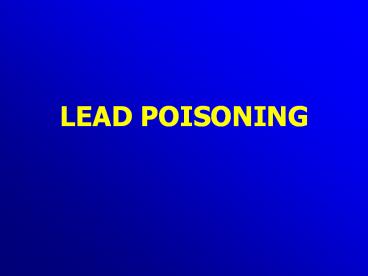LEAD POISONING - PowerPoint PPT Presentation
1 / 17
Title:
LEAD POISONING
Description:
... Ca Lead poisoning Storage & Distribution Rapid ... 50 mg/g lead i.e. 5.0 % 39 mg/g mercury i.e. 3.9 % i.e. 8.9 % heavy metals Blood ... – PowerPoint PPT presentation
Number of Views:166
Avg rating:3.0/5.0
Title: LEAD POISONING
1
LEAD POISONING
2
Lead poisoningAbsorption
- Skin
- little/no absorption
- Inhalation (lt1µm)
- dust or lead fumes
- absorb 50-70
- Oral
- adults absorb 10
- children absorb 40-50
- increased absorption if low Fe, Ca
3
Lead poisoningStorage Distribution
- Rapid turnover soft tissue pool
- T1/2 30-40 days blood, liver, kidney, CNS
- Slow turnover skeletal pool
- T1/2 10-20 years 75 - 90 in skeletal pool
- Chronic exposure results in a steady state
distribution between bone and blood - Excretion Renal (90) and biliary (10)
- Maximum excretion is 3.5µg/kg/day
- If intake gt 3.5 µg/kg/day accumulation will occur
4
Lead poisoningSources
- Occupational
- Lead smelters
- Painter/decorators
- Battery manufacturers
- Stain-glass workers
- Jewellery makers
- Bronze workers etc...
- Environmental
- paint (walls, furniture, toys)
- water
- food
- air (petrol, industry), dust/soil
- Other
- traditional remedies (Ayruvedic)
- surma kohl cosmetics
- lead shot
- lead glazed ceramics
- foreign body ingestion
- e.g. curtain/fishing weight, snooker chalk
5
Environmental lead exposureWater
- Lead in water
- Largely from lead pipes/solderings/fittings
- Water lead contamination from ground lead has
occurred in Nepal - WHO max water lead content 10µg/l
- 20-30 UK homes exceed this limit
6
Environmental lead exposurePaint
- Pre 1960s up to 40 lead in paint
- rapid drying, weather resistance, colouring
- Domestic paint now lt0.06 lead (600ppm)
- BUT leaded paint remains in many homes
- walls, furniture, toys
- Lead exposure from paint
- sanding, heat stripping, flaking, pica
- contamination of carpets/curtains, dust
7
Ayurvedic Traditional Remedies
- Numerous reports of lead, mercury, thallium,
arsenic poisoning from Ayurvedic ( Chinese)
remedies - 40 of the gt6000 medicines in Ayurveda contain at
least one heavy metal - Thought by practitioners to have therapeutic
properties and/or to increase the efficacy of
other herbal contents - Used most commonly for chronic disorders and so
there is a greater risk of heavy metal
accumulation
8
Ayurvedic Traditional Remedies
- Case 1 68 mg/g lead i.e. 6.8
- 76 mg/g mercury i.e. 7.6
- 12 mg/g arsenic i.e. 1.2
- i.e. 15.5 heavy metals
- Case 2 50 mg/g lead i.e. 5.0
- 39 mg/g mercury i.e. 3.9
- i.e. 8.9 heavy metals
9
Clinical features of lead poisoning
- Results in variable effects on many systems
- The effects are well established at high levels
- Infants/children get symptoms at lower levels
- Treatable, but can cause chronic sequelae
10
(No Transcript)
11
Low level lead poisoning and childrens IQ
- There have been many studies
- 5 prospective, 14 cross-sectional
- The problem is allowing for multiple confounders
- Three published metanalyses
- ?100µg/l blood lead
- ? ? IQ 2.5 points
12
Diagnosis of Lead Poisoning
- Blood lead is the best test (normal lt100µg/l)
- Other bloods
- FBC (film), UE, LFT, Ca, Vit D, Ferritin
- Radiology
- AXR ?lead in gut
- Long bone XR in children
- Other tests much less reliable
- Urine lead - variable, more useful for organic
lead - RBC Zn protoporphyrin, Urine coproporphyrin, dALA
13
Management of Lead Poisoning
- IDENTIFY REMOVE from SOURCE
- Treat coexisting iron ( calcium) deficiency
- Consider the use of chelation therapy
- - Good data for benefit with blood lead gt450µg/l
(children)
14
Chelating agents for lead poisoning
- 1. EDTA - Sodium calcium edetate
- 2. DMSA - Dimercaptosuccinic acid
- 3. BAL - Dimercaprol
- - IM for severe toxicity only, particularly
encephalopathy - 4. Penicillamine - no longer recommended
15
EDTA and DMSA
- EDTA - Sodium Calcium Edetate
- IV for severe toxicity, particularly
encephalopathy - Well tolerated, lt1 nephrotoxicity
- DMSA - 2,3dimercaptosuccinic acid
- The oral agent of choice for lead poisoning
- Given as a 19 day course
- Well tolerated
- The main problem is foul taste and smell !!
16
Treatment guidelines Children
- 100-240µg/l Remove from source, repeat level 1
month - 250-440µg/l Remove from source
- DMSA only if persists at
this level
450-690µg/l Remove from source DMSA
chelation gt700µg/l Remove from source
Urgent EDTA chelation (with
BAL if encephalopathy)
17
Treatment guidelines Adults
- 100-400µg/l Remove from source (??)
- Repeat level 3-6 mths
- 400-500µg/l Remove from source (?)
- Repeat level 1-2 mths
450-690µg/l Remove from source DMSA
chelation IF symptomatic gt700µg/l Remove
from source DMSA
chelation EDTA if neurological features































